
By John Essick
April 25th was National DNA Day, which celebrates completion of the Human Genome Project in 2003. Spearheaded in part by the National Human Genome Research Institute, the global mission of this education-focused initiative is to bring together students, teachers, and the public to learn more about genomics.
When completed in 2003, the Human Genome Project had produced a nearly complete human genome sequence, accounting for an estimated 92% of the human genome. Since then, innovative technologies have led to significant advances to fill in the gap of information contained in the remaining 8%. This resulted in the recent announcement that the Telomere-to-Telomere consortium had “published a collection of papers reporting the first truly complete sequence of the human genome.”
The first company dedicated to healthcare products derived from data found in the human genome was Myriad Genetics.[1] It was founded in 1991 by the two men most responsible for gene mapping and DNA sequencing (the technical advances that enabled the Human Genome Project), population geneticist Mark Skolnick and Dr. Walter Gilbert, along with Spencer Trask & Co. chairman Kevin Kimberlin.
The effort actually began in 1974, when Skolnick began to study genetic linkages in Mormon families searching for inherited disease traits.[2] To locate individual genes on a given chromosome, he and colleagues, David Botstein, Ron Davis and Ray White, developed the gene mapping method they called Restriction Fragment Length Polymorphisms.This breakthrough ability to locate any gene inspired Harvard University Professor, Gilbert, on May 27, 1985, to conceive of sequencing all 3 billion bits of DNA. Having earned the Nobel Prize for co-developing the first widely used method of sequencing DNA, Gilbert became the most ardent and visible advocate of what came to be known as the Human Genome Project.[3]
Myriad Genetics first delivered on its promise when it led a consortium that discovered the breast cancer mutations, BRCA1 and BRCA2, and then launched the first genetic testing lab.[4] Today the firm provides genomic insights to patients and their health care providers around the world. Services include assessments of: breast and ovarian cancer predisposition risk, prostate cancer disease progression, and whether DNA-repair drugs will help a woman based on her individual ovarian cancer. These and many other personalized genomic insights have saved many lives.
In three decades since the launch of the Human Genome Project, scientists have unlocked secrets about genes and how gaps and breakdowns in their communication and operation can lead to disease and death. As a result of this understanding, the complete reference of the human genome has revolutionized the treatment of common diseases and rare genetic disorders and positively impacted the lives of millions. Further advances in genomics will improve the welfare of future generations to come.
For additional resources and to learn more about National DNA Day, please visit https://www.genome.gov.
John Essick is a freelance writer and author who enjoys working with companies that are shaping our world through innovation. He specializes in collaborating with creative teams to turn ideas into content at every stage of a customer’s relationship.
